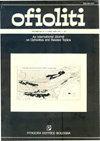土耳其安卡拉东部mÉlange伊兹米尔-安卡拉蛇绿岩中玄武岩-燧石组合的年龄和地球化学:初步资料
IF 1.3
4区 地球科学
Q2 GEOLOGY
引用次数: 15
摘要
在本文中,我们提出了沉积在属于东安卡拉混合岩(伊兹米尔-安卡拉混合岩的一部分)玄武岩顶部的放射虫燧石的年龄的初步数据。对玄武岩进行了岩石学研究,以限定所研究的玄武岩-燧石层序的构造背景。在安卡拉以东的9个剖面取样,并收集了27个样本进行生物地层和地球化学分析。本文测定的最古老的放射虫燧石属于晚三叠世(第6节:晚诺里亚),与OIB型玄武岩有关。在其他剖面也发现OIB型火山岩,与晚侏罗世(第三剖面:中晚牛津世至晚金默里纪-早梯东世)和早白垩世(第一剖面:晚瓦兰吉尼世至晚豪特里维世)的燧石有关。E-MORB型岩石与白垩纪(第4段:中晚巴雷米统-早阿普梯统)和第7段:瓦兰吉尼统-中阿普梯统-早阿普梯统)的放射虫类燧石有关,而最古老的n- morb型岩石则发现于晚侏罗世(第5段:早-早晚泰东统)。其他n- morb与早白垩世放射虫岩有关(第8节:晚瓦兰吉尼亚-早巴雷米尼亚)。P-MORBs型岩石仅在中侏罗世(第2段:早-中巴约世至晚bathonian -早Callovian)发现。本文记录了晚三叠世OIB型岩石的产状,以及在同一时间跨度(中晚侏罗世-早白垩世)中生成的具有不同地球化学亲和力的岩石(N-、E-、P-MORBs和OIB)的产状。n -MORB与MORB枯竭地幔源部分熔融产生的熔体成分相容。相反,oib与富集型地幔源的部分熔融是相容的。相对于DMM源,e - morb可能来源于稍微富集的地幔源,而p - morb则与相对于DMM源富集的地幔源产生的熔体相容。本文章由计算机程序翻译,如有差异,请以英文原文为准。
AGE AND GEOCHEMISTRY OF BASALT-CHERT ASSOCIATIONS IN THE OPHIOLITES OF THE IZMIR-ANKARA MÉLANGE EAST OF ANKARA, TURKEY: PRELIMINARY DATA
In this paper, we present the preliminary data on the age of the radiolarian cherts deposited on top of basalts belonging to the Eastern Ankara Melange (part of the Izmir-Ankara Melange). Petrological studies on the basalts were carried out in order to constrain the tectonic setting of the studied basalt-chert sequences. Nine sections were sampled East of Ankara and twenty seven samples were collected for biostratigraphic and geochemical analyses. The oldest radiolarian cherts dated in the present paper are referable to the Late Triassic (Section 6: late Norian) and are associated with basaltic rocks of OIB character. OIB type volcanic rocks are also found in other sections, associated with cherts of Late Jurassic (Section 3: middle-late Oxfordian to late Kimmeridgian-early Tithonian) and Early Cretaceous (Section 1: late Valanginian to late Hauterivian) ages. E-MORB type rocks are associated with radiolarian cherts of Cretaceous age (Section 4: middle late Barremian-early early Aptian and Section 7: Valanginian to middle Aptian-early Albian), whereas the oldest N-MORBs were found in a section of Late Jurassic age (Section 5: early-early late Tithonian). Other N-MORBs are associated with radiolarian cherts of Early Cretaceous age (Section 8: late Valanginian-early Barremian). P-MORBs type rocks were found only in a section of Middle Jurassic age (Section 2: early-middle Bajocian to late Bathonian-early Callovian age). In this work, we document the occurrence of Late Triassic OIB-type rocks and of rocks showing different geochemical affinities (N-, E-, P-MORBs and OIB) generated within the same time span (Middle-Late Jurassic - Early Cretaceous). N-MORBs are compatible with composition of melts generated by partial melting of a depleted MORB mantle source. In contrast, OIBs are compatible with partial melting of an enriched-type mantle source. E-MORBs may have derived from mantle source slightly enriched with respect to a DMM source, whereas P-MORBs are compatible with melts generated from a mantle source significantly enriched, compared to DMM.
求助全文
通过发布文献求助,成功后即可免费获取论文全文。
去求助
来源期刊

Ofioliti
地学-地质学
CiteScore
2.40
自引率
7.70%
发文量
1
期刊介绍:
Since 1976, Ofioliti provides an international forum for original contributions and reviews in the field of the geodynamics, petrology, geochemistry, biostratigraphy, stratigraphy, tectonics and paleogeography applied to ophiolitic terrains and modern oceanic lithosphere, including their sedimentary cover. Studies of topics such as geodynamics of the mantle, the evolution of orogens including ophiolites and paleoceanography are also welcome
 求助内容:
求助内容: 应助结果提醒方式:
应助结果提醒方式:


